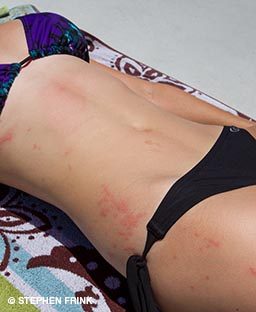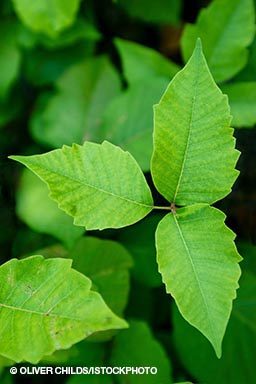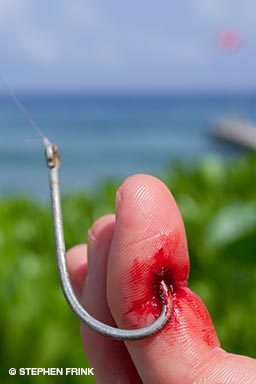Adventurous travelers go to great lengths to prepare for serious medical emergencies, but it’s often mundane and seemingly simple problems that interrupt trips or impair our ability to enjoy them. Prepare for minor annoyances to keep them from becoming major problems.
Sunbather’s Eruption

Often called “sea lice,” seabather’s eruption is most commonly used to describe itchy bumps that result from contact with thimble-jellyfish larvae or the larvae of other organisms with nematocysts (stinging cells).
The time of onset and location on the body can be helpful in identifying the cause. Sunscreen, sand, sweat, sun and saltwater can all irritate the skin, but stinging bumps that appear in covered areas of the body, especially at the cuffs or edges of swimwear, during or soon after exposure to seawater may be seabather’s eruption.
Treat seabather’s eruption just as you would a jellyfish or fire-coral sting: Rinse the area with vinegar, and apply heat to help relieve symptoms if the itching or discomfort is severe. Wash the affected area, and keep it clean and dry to promote healing. In severe cases, a doctor might prescribe an antihistamine or a steroid. The only practical prevention is avoidance; local dive centers should know when these organisms are present. True sea lice are fish parasites and don’t cause this condition.
Poison Ivy

Avoid contact with poison ivy (and other Toxicodendron species such as poison oak and poison sumac) by familiarizing yourself with these plants and learning where and when you’re likely to encounter them in your area. Their appearance can vary significantly by region and season. Poison ivy leaves, for example, are generally green but may have tinges of red and often change color in the fall. The leaves are typically almond-shaped, but one of the three in each cluster may be mitten-shaped. Edges are often serrated but to varying degrees. A Google image search is a fine place to start, but not every image you find on the Internet will be correctly labeled.
The nasty ingredient in Toxicodendron species is urushiol (uh-ROO-she-all), an oil contained in all the plants’ tissues. Allergic reactions to urushiol are common but vary in severity. If you come in contact with Toxicodendron leaves, remove the oil from your skin as soon as you are able; dish soap works well (it is designed to remove oils), but any available soap should help. Lather and rinse repeatedly. Soaps and other commercial products specifically designed to remove urushiol are available. It’s important to consider that the oil persists on gear and clothing virtually indefinitely. A washing machine or a thorough scrub with soap and water will generally remove urushiol.
Symptoms include itching, rash, blisters, weeping sores and more itching. The fluid that may ooze from the wounds will not spread the reaction, but any urushiol that persists on skin or clothing will. Treat the condition with an antihistamine such as diphenhydramine (Benadryl). Topical creams may bring temporary relief of itching, but even those containing a topical antihistamine or steroid won’t likely affect the duration or severity of symptoms very much. For serious cases, see a doctor, who will likely prescribe an oral steroid.
Blisters
Prevent friction blisters before they occur by addressing hot spots — the precursors of blisters. Cover hot spots with moleskin (a commercially available product used for blister care) or medical tape to reduce friction. Use scissors to round the edges of the moleskin or tape before application because sharp corners are more prone to peeling off.
If a blister has already appeared, make a “doughnut” out of moleskin (one or more layers thick) or Molefoam (a thicker version of moleskin) to reduce friction on the blister.
If possible, leave blisters intact — resist the temptation to break them. Intact blisters heal more quickly. However, sometimes it will be impossible to leave a blister intact. A hiker in the middle of a trip, for example, has little choice but to put his feet back into his boots and keep walking. In situations like these, it is appropriate, and indeed preferable, to break blisters intentionally. Use a sanitized needle or sharp blade, and make a puncture or small incision near the blister’s edge. Make the perforation at the bottom of the blister if applicable (with a heel blister, for example) as this makes use of gravity to help the blister drain. Add a little antibiotic ointment and cover just as you would for other small, superficial wounds.
It’s difficult to get tape to adhere to skin in wet environments, so use tincture of benzoin, a medical adhesive available at many drug stores, to help.
Fish Hooks

The general rule regarding impaled objects is to not remove them. There are a few exceptions to this, which include small objects lodged in fingers or toes. Never attempt to remove a hook from the face or an eye; stabilize it in place and get the victim medical attention as soon as possible.
One proven method of fish-hook removal is known as the string-yank technique. First, tie a piece of fishing line around the curve in the hook. Then, press the shank of the hook downward toward the skin. The resulting levering action should disengage the barb inside the wound. Using the line you tied, quickly snatch the hook out of the wound in the direction from which it entered.
Alternatively, if the sharp end of the hook emerges from the skin or is very close to doing so, it’s not unreasonable to push the hook through until the barb appears and clip it off. The hook can then be backed out.
Always wash the area around the wound thoroughly. Puncture wounds are especially prone to infection, so monitor the injury site closely for a couple of days following removal. Increasing stiffness or other signs of infection warrant prompt evaluation by a doctor.
Infected Wounds

Scratches, insect bites, broken blisters and other wounds are common in wilderness environments, and they may be more prone to infection than when they occur at home. Sweat, dirt, physical stress, high altitude, a less-varied diet and suboptimal hygiene are all factors that can predispose wilderness travelers to infected wounds.
The acronym SHARP can help you assess whether a wound is getting infected. SHARP stands for swelling, heat, aches/pains, redness and pus. Wounds that aren’t infected or are only minimally so won’t be particularly swollen or hot to the touch, they won’t have associated deep-tissue soreness, and redness and pus will be minimal. Seriously infected wounds may cause stiffness or soreness, and red streaks may be visible. Pus may be abundant, and the patient may have a fever or general malaise. Any signs of serious infection should be considered a medical emergency and require immediate medical attention.
The best way to keep wounds from getting infected is to clean them thoroughly right after they occur, dress and bandage them, and change the dressings daily. If signs of infection appear, reclean the wound, apply moist heat (as hot as the patient can tolerate) every 4 to 6 hours, and change the dressings multiple times per day. Give over-the-counter pain medications such as ibuprofen, and promote rest and hydration. For remote trips, consider talking to your doctor about options for antibiotic therapy before you travel. If symptoms of infection do not respond promptly to available treatment, get the patient medical attention as soon as possible.
Water Disinfection
Gastrointestinal distress from drinking contaminated water is generally avoidable. In places where the local water isn’t safe to drink (or it’s questionable), you’ll want to have options for making water potable. This may be useful in certain parts of the world, in disaster situations or when traveling in the backcountry and taking water directly from lakes, springs, rivers or streams. There are several factors to consider when deciding which method of water purification is most suitable for your situation; these include cost, time and weight.
Chemical treatments for sanitizing water are readily available at outdoor stores; the most common of these are preparations of iodine or chlorine. Make sure to follow the manufacturer’s guidelines regarding the contact time these chemicals require. Many of the available products take as little as 20 or 30 minutes to kill most microorganisms but as long as 4 hours to kill some organisms such as cryptosporidium. Colder water may require longer contact times. Two downsides of chemical treatment are the delay before you can drink the water and, depending on the chemical, the taste. If you use powdered drink mix to flavor your water, wait until the water is safe to drink before adding the flavoring; some drink mixes can interfere with disinfection.
Boiling is a straightforward option; all you need is an adequate heat source and a vessel in which water can be heated. There is no need to boil for any particular length of time; as long as water reaches a full boil, no matter the altitude, you can be confident all bacteria, protozoa, viruses and parasites are dead. Boiling is time- and labor-intensive compared to other methods, but it’s reliable. If you’re carrying your fuel with you, it can also be space- and weight-intensive.
Filtration allows quick access to water, and most filters don’t affect taste. Many filters make use of small hoses and a pump so water can be obtained from even the smallest pools, springs or puddles. Some are unable to remove viruses; this depends on pore size. Some filters with pores that aren’t small enough to remove viruses use chemicals to kill them. Small personal water filters may be too time-consuming to use for larger groups; multiple filters might be needed.
Ultraviolet (UV) radiation is widely used to disinfect municipal water supplies, and as of about 10 years ago, lightweight, hand-held devices are available for personal water disinfection. The SteriPEN was the first of these to hit the market and is still the most well known. The device is turned on, dipped into the water and stirred for about a minute. It uses a lamp to emit UV radiation, which destroys the DNA of any microbes present, rendering them harmless to humans. UV disinfection doesn’t affect taste, and there is no danger from overexposing the water to the radiation — longer contact times increase the margin of safety. Cost is similar to that of filters.
As with major medical problems, preparation and prevention are the best methods of managing the small stuff. A proactive mindset will help ensure you aren’t caught off guard by “minor” mishaps and injuries.